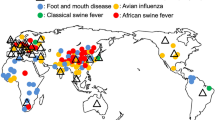Abstract
IN the report in Nature1 on the occurrence of ‘whiptail’ in cauliflower in Great Britain, it was stated that this deficiency disease, attributable to molybdenum2,3, is endemic in south-eastern England. From observations and experiments carried out at this Station since 1947, ‘whiptail’ in cauliflower and broccoli is prevalent in most of the market-garden districts of the south of England and Wales, and particularly in the broccoli-growing areas of Cornwall. The problem occurs on acid soils, and a wide range of different parent materials is involved, including granite, Devonian shales and sandstones, Carboniferous Limestone and Lower Greensand.
Similar content being viewed by others
References
Jones, J. O., and Dermott, W., Nature, 165, 248 (1950).
Davies, E. B., Nature, 156, 392 (1945).
Hewitt, E. J., and Jones, E. W., J. Pomology and Hort. Sci., 23, No. 3 and 4 (1947).
Hewitt, E. J., and Jones, E. W., Ann. Rept. Long Ashton Res. Stat. 1948, 81 (1948).
Author information
Authors and Affiliations
Rights and permissions
About this article
Cite this article
PLANT, W. Use of Lime and Sodium Molybdate for the Control of ‘Whiptail’ in Broccoli. Nature 165, 533–534 (1950). https://doi.org/10.1038/165533b0
Issue Date:
DOI: https://doi.org/10.1038/165533b0
- Springer Nature Limited
This article is cited by
-
Interrelationships among iron, manganese, and molybdenum in the growth and nutrition of tomatoes grown in culture solution
Plant and Soil (1960)
-
Production of ‘Whiptail’ in Cauliflower Grown in Sand Culture
Nature (1951)
-
Use of Aspergillus Niger as a Test Organism for Determining Molybdenum Available in Soils to Crop Plants
Nature (1950)





